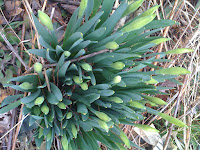 |
| A CLUSTER OF EMPTY VASES READY TO FILL |
The wind blows fiercely, and in the yard, lawn furniture is overturned and twigs, branches, and even limbs snap off of trees and tumble to the ground. It seems like every day we right the chairs and carry broken branches to the mulch pile, but the spring yard is always in disarray. Ursula finds plenty of sticks to coax us into a game. Our dog loves to fetch. The big bushes in the front yard—some kind of dusky pink kin to the rose—has put out flower buds. They are like pink capers, wrapped tight against the wind. But the surest sign of spring in Birdland is peeping next to the wood stove. That's where the brooder is. Okay, you knew I was going to go back to that farm store and get those chicks, didn't you? We have a dozen. Six Buff Orpingtons, and three each of Rhode Island Reds and Barred Rock. They are straight run, which means that half will be pullets and half cockerels, the natural ratio. At the time, a dozen seemed like plenty, but suddenly only 6 hens next year seems like such a small number, especially accounting for predation. Maybe I'd better go back before the sale ends.
 |
| HEAR YE, HEAR YE! SPRING COMES EARLY THIS YEAR! |
For now the chicks are in the brooder, under lights, but I hope soon the wind will die down, so I can set up a temporary pen in the grass. They'll be less bored outside, where they can scratch in the ground and snap up grass and dandelion greens. They'll be healthier, too, and easier to keep clean. Chicks only get “pasty butt” when they are in an artificial brooder. In the yard, grazing on a more varied and natural diet, they are in a better balance. Once they feather out and lose their soft down, they won't even need a light. Won't they be surprised to discover that the world is wider than the plastic crate they live in now?
 |
| Like Birthday Candles with Yellow Flame |
 |
| Hatch in Beauty: Bloom in Peace: Blessed be. |
The wind will die down; the sun will coax open more buds; new chicks will scratch and graze. Spring will come and leave us again to make way for summer.













No comments:
Post a Comment